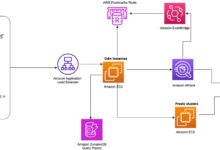AWS CDK: 7 Powerful Reasons to Automate Cloud Like a Pro
Imagine building complex cloud infrastructure with the same ease as writing a simple app. That’s the magic of AWS CDK—where code becomes your cloud blueprint, fast, scalable, and error-free.
What Is AWS CDK and Why It’s a Game-Changer

AWS CDK, or Amazon Web Services Cloud Development Kit, is an open-source software development framework that allows developers to define cloud infrastructure using familiar programming languages. Unlike traditional Infrastructure as Code (IaC) tools that rely on YAML or JSON templates, AWS CDK uses real code—like TypeScript, Python, Java, C#, or Go—to model and deploy AWS resources.
How AWS CDK Differs from CloudFormation
AWS CloudFormation has long been the backbone of AWS infrastructure provisioning, using declarative JSON or YAML templates to describe stacks. While powerful, it often leads to verbose, hard-to-maintain configuration files. AWS CDK, on the other hand, sits on top of CloudFormation but introduces a higher level of abstraction using imperative code.
Instead of manually writing every resource in JSON, you define your infrastructure using classes and methods. The CDK then synthesizes this into standard CloudFormation templates during deployment. This means you get the reliability of CloudFormation with the flexibility and reusability of programming constructs like loops, conditionals, and functions.
- AWS CDK generates CloudFormation templates under the hood
- Supports multiple programming languages (TypeScript, Python, Java, etc.)
- Enables logic-driven infrastructure definitions
“AWS CDK bridges the gap between developers and DevOps by speaking the language of code.” — AWS Official Documentation
Core Components of AWS CDK
The AWS CDK architecture revolves around three fundamental building blocks: Stacks, Constructs, and Apps.
A Stack represents a unit of deployment, equivalent to a CloudFormation stack. You can define multiple stacks within a single CDK app—for example, one for staging and another for production.
A Construct is the basic building block of AWS CDK. It represents a cloud component, such as an S3 bucket, Lambda function, or an entire API Gateway with backend services. Constructs can be nested, allowing you to build higher-level abstractions.
An App is the root of your CDK project. It contains one or more stacks and serves as the entry point for synthesis and deployment.
These components work together to create a hierarchical, reusable, and modular infrastructure definition.
Top 7 Benefits of Using AWS CDK
The AWS CDK isn’t just another IaC tool—it’s a paradigm shift in how we think about cloud infrastructure. Its advantages go beyond syntax and touch on productivity, collaboration, and scalability.
1. Write Infrastructure in Real Programming Languages
One of the most compelling features of AWS CDK is its support for mainstream programming languages. Developers can use TypeScript, Python, Java, C#, or Go to define infrastructure, leveraging IDE support, autocompletion, linting, and testing frameworks.
This means you can use variables, functions, classes, and even unit tests to validate your infrastructure logic. For example, you can write a function that creates a secure S3 bucket with versioning, encryption, and lifecycle policies—all reusable across projects.
Compared to static YAML files, this approach drastically reduces duplication and improves maintainability. You’re no longer copy-pasting templates; you’re building infrastructure libraries.
2. Reusability Through Custom Constructs
AWS CDK encourages the creation of reusable components called Constructs. These can be shared across teams or published as open-source packages via the Construct Hub (https://constructs.dev).
For instance, your organization might have a standard pattern for serverless APIs: API Gateway + Lambda + DynamoDB + Cognito. Instead of redefining this stack every time, you can encapsulate it into a custom Construct and reuse it with minor configuration changes.
This promotes consistency, reduces errors, and accelerates development cycles. Teams can focus on business logic rather than reinventing infrastructure patterns.
3. Faster Development with High-Level Constructs
AWS CDK provides three levels of constructs: L1 (low-level), L2 (medium-level), and L3 (high-level).
- L1 Constructs are direct 1:1 mappings to CloudFormation resources (e.g.,
CfnBucket). - L2 Constructs add usability by providing sensible defaults and methods (e.g.,
Bucketwith encryption enabled by default). - L3 Constructs represent entire patterns (e.g.,
ApplicationLoadBalancedFargateService).
Using high-level constructs, you can deploy complex architectures with just a few lines of code. For example, launching a containerized web app on ECS with load balancing, auto-scaling, and VPC networking can be done in under 50 lines of TypeScript.
This level of abstraction dramatically speeds up prototyping and deployment, especially for common architectures.
Getting Started with AWS CDK: Installation and Setup
Setting up AWS CDK is straightforward and developer-friendly. Whether you’re using TypeScript, Python, or another supported language, the process is well-documented and integrates smoothly with existing workflows.
Prerequisites and Environment Setup
Before installing AWS CDK, ensure you have the following:
- Node.js (for TypeScript/JavaScript) or Python/pip (for Python projects)
- AWS CLI installed and configured with valid credentials (https://aws.amazon.com/cli/)
- An AWS account with appropriate IAM permissions
- Git (optional, for version control)
For TypeScript users, Node.js 14.x or later is required. You can verify your installation with node --version and npm --version. Once ready, install the AWS CDK CLI globally using npm:
npm install -g aws-cdk
After installation, verify it with cdk --version. This should output the current CDK version, confirming a successful setup.
Creating Your First CDK Project
To initialize a new CDK project, run:
cdk init app --language typescript
This command creates a boilerplate project structure with essential files:
bin/: Contains the entry point for your applib/: Where your stacks are definedcdk.json: Configuration file for the CDK toolkitpackage.json: Node.js project metadata and dependencies
Inside lib/, you’ll find a default stack file (e.g., hello-cdk-stack.ts). This is where you’ll define your AWS resources. For example, adding an S3 bucket is as simple as importing s3.Bucket and instantiating it within the stack.
Once your code is ready, deploy it using:
cdk deploy
The CDK CLI will synthesize the CloudFormation template, prompt for confirmation, and deploy the stack to your AWS account.
Understanding Constructs: The Building Blocks of AWS CDK
At the heart of AWS CDK’s power lies the concept of Constructs. These are reusable, composable components that represent AWS resources or patterns. Understanding how to use and create constructs is key to mastering AWS CDK.
What Are Constructs and How Do They Work?
A Construct is a class that encapsulates one or more AWS resources. When you instantiate a construct in your CDK app, it becomes part of the construct tree, which the CDK uses to generate the final CloudFormation template.
Constructs are hierarchical. For example, a VPC construct might contain subnets, route tables, and internet gateways—all defined within a single logical unit. This hierarchy enables clean separation of concerns and promotes modularity.
Every construct must be defined within a scope (usually a Stack or another Construct) and given an ID. This ID must be unique within its scope and is used to track the resource during synthesis.
Example in TypeScript:
new s3.Bucket(this, 'MyBucket', { versioned: true });Here, this is the scope (likely a Stack), 'MyBucket' is the ID, and the third argument is configuration.
Levels of Constructs: L1, L2, and L3
AWS CDK categorizes constructs into three levels based on abstraction:
- L1 (Cfn*): Generated directly from CloudFormation specifications. They offer full control but require manual configuration of every property.
- L2: Built on top of L1, these provide sensible defaults and convenience methods. For example,
s3.Bucketenables encryption by default. - L3 (Patterns): High-level constructs that represent common architectural patterns. Examples include
aws-ecs-patterns.ApplicationLoadBalancedFargateService.
Choosing the right level depends on your needs. Use L2 for most use cases, L1 when you need granular control, and L3 for rapid deployment of standard architectures.
Creating and Sharing Custom Constructs
One of AWS CDK’s most powerful features is the ability to create custom constructs. These can be shared across teams or published to the public Construct Hub.
To create a custom construct, define a new class that extends Construct:
export class SecureBucket extends Construct {
constructor(scope: Construct, id: string) {
super(scope, id);
new s3.Bucket(this, 'Bucket', {
encryption: s3.BucketEncryption.S3_MANAGED,
versioned: true,
removalPolicy: RemovalPolicy.RETAIN
});
}
}This SecureBucket can now be reused anywhere in your project or shared as a package. By publishing it to npm or a private registry, other teams can install and use it seamlessly.
This model fosters infrastructure standardization and reduces the risk of misconfigurations.
Deploying Applications with AWS CDK Pipelines
While defining infrastructure is important, automating its deployment is crucial for reliability and speed. AWS CDK integrates natively with AWS CodePipeline to enable fully automated CI/CD workflows for your infrastructure and applications.
What Is CDK Pipelines?
CDK Pipelines is a high-level construct (pipelines.CodePipeline) that automates the deployment of your CDK applications. It sets up a source stage (e.g., from GitHub or CodeCommit), a build stage (using CodeBuild), and multiple deployment stages (dev, staging, prod).
The pipeline automatically detects changes in your CDK code, builds the application, synthesizes the CloudFormation templates, and deploys them across environments with manual approval gates if needed.
Unlike traditional CI/CD setups that require extensive YAML configuration, CDK Pipelines are defined in code—making them version-controlled, testable, and reusable.
Setting Up a CI/CD Pipeline in Minutes
Creating a pipeline is as simple as instantiating the CodePipeline construct and adding stages:
const pipeline = new pipelines.CodePipeline(this, 'Pipeline', {
synth: new pipelines.ShellStep('Synth', {
input: pipelines.CodePipelineSource.gitHub('org/repo', 'main'),
commands: ['npm ci', 'npm run build', 'npx cdk synth']
})
});
pipeline.addStage(new MyApplicationStage(this, 'Prod', {
env: { account: '123456789012', region: 'us-east-1' }<br}));This code creates a pipeline that pulls from GitHub, runs the build commands, and deploys to a production stage. You can add additional stages with different environments or add manual approval steps using addManualApproval().
The entire pipeline is deployed as part of your CDK app, meaning your CI/CD infrastructure is also versioned and managed as code.
Best Practices for Pipeline Security and Governance
When automating deployments, security and governance are paramount. AWS CDK Pipelines support several best practices:
- Use IAM roles with least privilege for pipeline execution
- Enable cross-account deployments securely using AWS Organizations and Service Catalog
- Implement manual approval steps for production deployments
- Enable logging and monitoring via CloudWatch and AWS CloudTrail
You can also integrate security scanning tools (like cfn-nag or Checkov) into the build phase to detect misconfigurations before deployment.
By embedding security into the pipeline, you achieve a true DevSecOps model where compliance is automated and continuous.
Comparing AWS CDK with Terraform and Other IaC Tools
While AWS CDK is powerful, it’s not the only Infrastructure as Code (IaC) tool available. Terraform, CloudFormation, Pulumi, and others also offer robust solutions. Understanding the differences helps you choose the right tool for your use case.
AWS CDK vs. Terraform: Key Differences
Terraform, developed by HashiCorp, is a widely adopted IaC tool that uses HashiCorp Configuration Language (HCL) to define infrastructure across multiple clouds. It’s known for its state management and provider ecosystem.
Key differences include:
- Language Support: Terraform uses HCL (declarative), while AWS CDK uses real programming languages (imperative).
- Cloud Focus: Terraform is multi-cloud; AWS CDK is AWS-specific (though experimental multi-cloud support exists via CDK for Terraform).
- State Management: Terraform relies on state files to track resources; AWS CDK uses CloudFormation’s built-in state management.
- Learning Curve: HCL is easier for beginners; CDK requires programming knowledge but offers more flexibility.
For AWS-centric teams with strong development skills, AWS CDK often provides a more natural fit.
When to Use AWS CDK Over CloudFormation
CloudFormation is the foundation of AWS CDK, but CDK enhances it significantly. Use AWS CDK when you need:
- Logic and conditionals in your infrastructure (e.g., environment-specific settings)
- Reusability across projects via custom constructs
- Integration with application code in the same repository
- Faster development with high-level patterns
Stick with raw CloudFormation if you prefer declarative templates, have strict compliance requirements that mandate template review, or work in environments where programming languages are restricted.
Pulumi vs. AWS CDK: A Developer’s Perspective
Pulumi is another code-based IaC tool that allows you to use real languages (Python, TypeScript, etc.) to define infrastructure. Like AWS CDK, it supports imperative programming and multi-cloud deployments.
However, Pulumi manages its own state backend and doesn’t rely on CloudFormation. This gives it more flexibility but removes the auditability and rollback features of CloudFormation.
AWS CDK, by generating CloudFormation templates, inherits all the benefits of AWS’s native orchestration engine—making it a safer choice for enterprises already invested in AWS tooling.
Advanced AWS CDK Patterns and Use Cases
As teams grow more comfortable with AWS CDK, they begin to adopt advanced patterns that maximize reusability, security, and scalability. These patterns go beyond basic resource definition and touch on enterprise-grade architecture.
Multi-Stack and Multi-Account Deployments
In enterprise environments, infrastructure often spans multiple AWS accounts (e.g., dev, staging, prod) and regions. AWS CDK supports this through programmatic stack instantiation and environment specification.
You can define a stage class that encapsulates a complete environment:
export class ApplicationStage extends Stage {
constructor(scope: Construct, id: string, props: StageProps) {
super(scope, id, props);
new MyWebService(this, 'WebService');
}
}Then deploy it across accounts:
pipeline.addStage(new ApplicationStage(app, 'Dev', {
env: { account: 'dev-account-id', region: 'us-west-2' }<br}));
pipeline.addStage(new ApplicationStage(app, 'Prod', {
env: { account: 'prod-account-id', region: 'us-east-1' }<br}));This enables consistent, auditable deployments across environments with minimal duplication.
Infrastructure Testing and Validation
One of the biggest advantages of using code for infrastructure is the ability to test it. AWS CDK supports unit and integration testing using standard testing frameworks like Jest (for TypeScript) or pytest (for Python).
You can write assertions to verify that your stack contains the right resources with correct configurations:
test('S3 Bucket Created with Encryption', () => {
const app = new App();
const stack = new MyStack(app);
const s3Bucket = Testing.synth(stack).findResource('AWS::S3::Bucket');
expect(s3Bucket.Properties.BucketEncryption).toBeDefined();
});This shifts infrastructure validation left in the development cycle, catching errors before deployment.
Custom Construct Libraries and Internal Marketplaces
Large organizations use AWS CDK to create internal construct libraries that enforce security, compliance, and operational best practices.
For example, a financial services company might publish a SecureLambdaFunction construct that automatically enables encryption, VPC, logging, and monitoring—ensuring all Lambda functions meet regulatory standards.
These libraries can be versioned, documented, and distributed via private npm or PyPI repositories, creating an internal “infrastructure marketplace” for developers.
Common Pitfalls and How to Avoid Them
While AWS CDK is powerful, it comes with its own set of challenges. Being aware of common pitfalls can save you time and prevent costly mistakes.
Overusing Custom Logic in Constructs
Because AWS CDK allows full programming capabilities, it’s tempting to add complex logic directly into constructs. However, this can make infrastructure harder to understand and debug.
Best practice: Keep constructs focused on resource definition. Move complex business logic to external services or application code.
Ignoring Synthesized Template Size
CDK apps are synthesized into CloudFormation templates, which have size limits (460,800 bytes). Large applications with many resources can exceed this limit.
Solution: Use nested stacks to break down large templates into smaller, manageable pieces. CDK supports this via NestedStack classes.
Hardcoding Sensitive Values
Never hardcode secrets like database passwords or API keys in your CDK code. Instead, use AWS Secrets Manager or SSM Parameter Store.
Example:
const dbPassword = SecretValue.secretsManager('my-db-password');This keeps credentials secure and enables rotation and auditing.
What is AWS CDK?
AWS CDK (Cloud Development Kit) is an open-source framework that lets developers define cloud infrastructure using familiar programming languages like TypeScript, Python, Java, and C#. It compiles code into AWS CloudFormation templates for deployment.
How does AWS CDK differ from Terraform?
AWS CDK uses real programming languages and targets AWS exclusively, while Terraform uses HCL and supports multiple clouds. CDK leverages CloudFormation for state management; Terraform uses its own state backend.
Can AWS CDK be used for multi-account setups?
Yes, AWS CDK supports multi-account and multi-region deployments through programmatic environment specification and integration with AWS Organizations and SSO.
Is AWS CDK free to use?
Yes, AWS CDK is open-source and free. You only pay for the AWS resources you provision through it, not the CDK tooling itself.
Where can I find pre-built CDK constructs?
Pre-built constructs are available on the Construct Hub at https://constructs.dev, which hosts thousands of open-source CDK components.
Amazon Web Services has evolved from simple infrastructure provisioning to a fully programmable cloud platform, and AWS CDK sits at the forefront of this transformation. By enabling developers to define infrastructure using real code, it bridges the gap between application development and operations. With powerful features like reusable constructs, CI/CD integration, and testing capabilities, AWS CDK is not just a tool—it’s a new way of thinking about cloud architecture. Whether you’re a startup building your first app or an enterprise managing hundreds of accounts, AWS CDK offers the scalability, security, and speed needed to thrive in the modern cloud era.
Recommended for you 👇
Further Reading:









